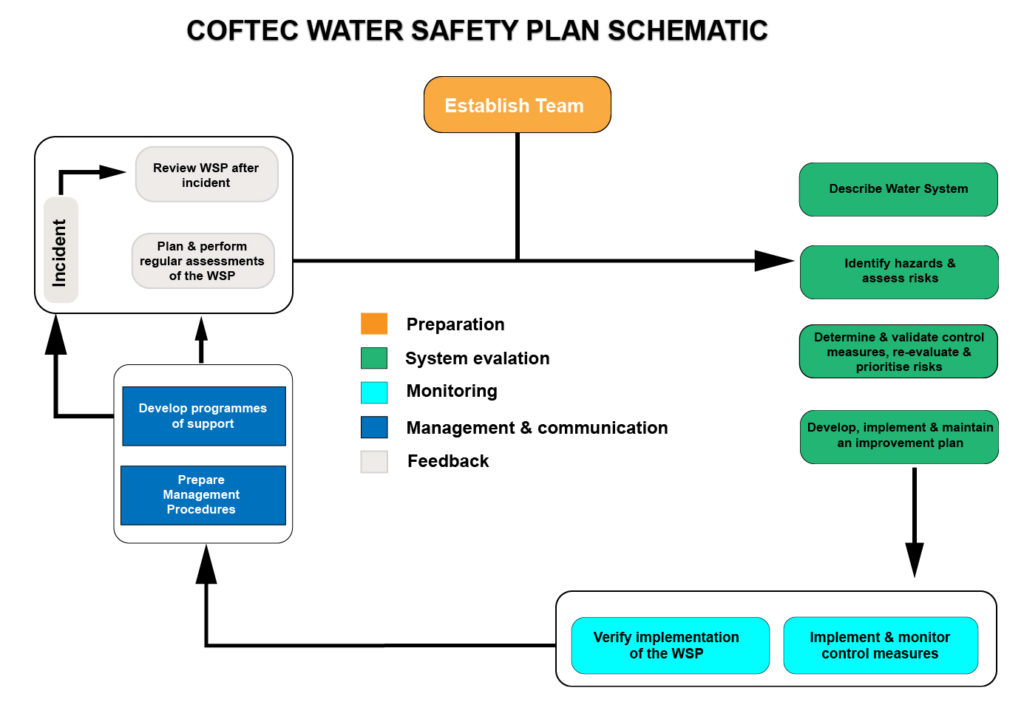
Blog
What is a Water Safety Plan for Industrial Water?
A water safety plan for industrial water is a document that outlines the steps taken to ensure the safety of water for a specified process. It is a systematic approach to identifying, assessing, and managing risks to water quality throughout the entire water supply chain, from the source to the point of use in the process.
In the next few sections, we will discuss the key components of a water safety plan for industrial water and the steps involved in developing and implementing a plan in the industrial setting.
Importance of a Water Safety Plan for Industrial Water
For industrial facilities that utilise large volumes of water within manufacturing and other processes, implementing a comprehensive Water Safety Plan is critically important to mitigate risks and assure operational continuity. Contamination or disruption of the water supply can severely impact output, quality, compliance, and profitability across sectors like pharmaceuticals, food and beverages, semiconductors, pulp and paper, textiles, and more. These industries rely on ample volumes of clean water for vital purposes including fabricating, processing, washing, diluting, cooling, and transporting products. Any compromise to the quantity or quality of the water supply directly translates to reduced production and revenue.
Why Water Safety Plans are Needed
A Water Safety Plan provides an optimised framework to proactively identify potential threats, manage risks, respond effectively to incidents, and safeguard the integrity of the water supply from catchment to point of use. For industrial users, consistently accessing uncontaminated water in required amounts is an essential prerequisite to manufacturing high-quality goods efficiently, safely, and profitably. A customised Water Safety Plan tailored to the site’s specific needs and risks is, therefore, a strategic investment that reaps major dividends across operational resilience, regulatory adherence, hazard mitigation, and business continuity.
Managing Water Risks with WHO and EPA Methodologies
The World Health Organisation published the ‘Water Safety Plan Manual: Stop-by-step risk management for drinking water supplies’ in 2009 which recommended that water suppliers develop and implement a “Water Safety Plan” (WSP) to systematically assess and manage risks in relation to drinking water quality. The document stated that “The most effective means of consistently ensuring the safety of a drinking-water supply is a comprehensive risk assessment and risk management approach that encompasses all steps in water supply from catchment to consumer”. Similarly, wastewater discharged to receiving sewer networks or water bodies must comply with legislative limits outlined in Integrated Pollution Control (IPC) Licences. Regarding overall water infrastructure the Environmental Protection Agency (EPA), adopted the approach of the WHO. It states, “A supply is deemed ‘safe’ if it meets the relevant standards and if a management system is in place that identifies all potential risks and solutions are in place to manage these risks”.
The water safety planning approach has specific utility within the industrial sector. For instance, manufacturing and other industries use water during the production process for either creating their products or cooling equipment used in the production process. Raw water entering an industrial process often needs treatment to meet tight quality specifications. The input water quality requirements will vary considerably depending on the application, region, and local regulations. In addition, effluent streams from industrial facilities must have appropriate management plans in place. A properly developed Water Safety Plan will ensure the safety of both the water entering and leaving the facility through a risk assessment and management process that considers all points in the source water supply system through to the final process. The water safety planning approach is a means to prevent and manage threats to the water supply, before anything goes wrong, considering all stages of the supply process from the catchment to the process itself. By taking a proactive approach to water safety, industrial facilities can reduce the likelihood of water-related incidents and ensure the quality and safety of their water supply.
What Does the Plan Include?
A Water Safety Plan for industrial water has 3 main components:
• Assessment of the water infrastructure from source to end-point
• Effective control monitoring
• Development and deployment of technical solutions

Steps in Developing a Water Safety Plan
(i) Assessment of the Water Infrastructure
The initial step of putting a Water Safety Plan in place requires assembling a cross-functional team comprising experts involved in each stage of the water supply and treatment process. This may include civil, chemical, mechanical, and electrical engineers, microbiologists, chemists, operators, maintenance personnel, management representatives, and external stakeholders.
This diverse team is tasked with systematically documenting and capturing all identifiable risks and hazards to the water supply and each element of the treatment system. This is done through extensive on-site assessments of the water sources, transmission infrastructure, treatment processes, storage facilities, and distribution network. The team evaluates available data on water quality trends, treatment efficacy, operational parameters, maintenance records, and prior incidents or failures.
The assessments focus on identifying risks from catchment to consumer, including threats from input water contamination, treatment failures, cross-connections, pipe corrosion/leaks, water age and stagnation, backflows, and contamination during storage and distribution. Potential hazards from physical assets, chemicals, materials, procedures, human factors, and external events are considered. Thorough and systematic risk assessments are the core element in the development of a comprehensive water safety plan for industrial water.
All elements of the water supply network must be thoroughly analysed to ensure overall safety and integrity. The risks identified are carefully evaluated and prioritised. Appropriate control measures are then developed to mitigate the identified risks and hazards. The result is a comprehensive plan tailored to the specific water system that addresses all aspects of water safety and risk management.
(ii) Effective Control Monitoring for Water Safety Plan
Once risks have been identified and assessed, appropriate control measures must be implemented to reduce and manage these risks. This involves utilising various treatment processes, control systems, alarms, employee training protocols, and other preventive measures.
For example, control measures may include filtration and disinfection to remove or inactivate microbiological contaminants, corrosion control to prevent pipe deterioration, cross-connection controls, routine inspection and maintenance schedules, and emergency response plans. Control measures should cover normal operations as well as unexpected scenarios such as flooding or damage to infrastructure.
There should be contingency plans for emergency process water supply in case of a hazardous event that disrupts normal operations. Control measures may also include public communication strategies to avoid panic during incidents.
The next crucial stage is to validate that the chosen control measures are functioning as intended. Validation demonstrates that a control measure consistently achieves its performance requirements and intended purpose. For example, validation tests could artificially introduce a hazard and then monitor it to confirm the control measure effectively prevented or reduced the hazard.
Validating treatment processes involves challenging the treatment system under worst-case conditions and verifying it still produces water that meets quality specifications. Validation provides confidence that the control measures will reliably and adequately control identified risks and keep hazards at acceptable levels. Ongoing supervision serves to ensure optimal performance is maintained after validation.
(iii) Documentation & Deployment of Technical Solutions for Water Safety Plan
Once the initial assessment of the water system is complete, an improvement/action plan should be created. These plans illustrate the current performance of the treatment system and outline priorities for enhancing the system to better control identified risks.
For example, the action plan may include additional treatment barriers, increased review capabilities, infrastructure upgrades, enhanced maintenance programs, staff training, and other measures to continually improve the water safety program. There should be clear accountability and timelines assigned for implementing the actions.
Another critical activity is ongoing operational monitoring. This must be constantly carried out while the site is running to ensure all critical water quality parameters and control measures are operating within specifications and standards. This includes both measurable monitoring, like recording turbidity, chlorine residual, pH and BOD (biochemical oxygen demand) levels, as well as observational monitoring, like inspecting for pipe leakages or damage to site fencing.
Out-of-specification results or observations must trigger appropriate corrective actions like process adjustments, equipment maintenance or repairs. Trend analysis of system data can reveal gradual changes requiring intervention before a major failure occurs.
There should also be regular review and reassessment of the identified hazards, risks and existing control measures. The water safety plan should be a living document, updated to reflect learnings, new risks, and continually improving practices.
The water safety plan should be clearly and comprehensively documented and readily available for review by clients, regulators, and other stakeholders to demonstrate due diligence and build trust.
What are the Benefits of a Water Safety Plan for Industrial Water?
As outlined in the previous sections, a water safety plan provides a comprehensive framework for industrial facilities to proactively assess and manage risks related to their water supply and usage. Implementing such a plan confers numerous benefits, including:
- Ensuring infrastructure cleanliness, safety, and compliance with all applicable standards. Preventative maintenance and treatment optimisation keep pipelines, tanks, and equipment in reliable working order.
- Increased efficiency and cost savings by identifying issues early before they escalate. Catching problems while still minor reduces downtime and repair expenses.
- Control measures tailored to each facility’s specific risks and optimized through ongoing validation and improvement. This provides effective protection matched to the site’s needs.
- A dynamic plan that evolves with the facility’s risk profile over time through continued reassessment, monitoring, auditing, and updating of control measures.
- Maintaining compliance with evolving regulatory requirements related to water use, treatment, discharge, and testing. This avoids violations and associated legal consequences.
- Comprehensive training programs to ensure personnel competency in water management procedures, protective equipment usage, sampling, and hazard mitigation.
- Emergency response plans tailored to potential incidents based on risk assessments. This facilitates rapid, effective action during unplanned events to protect water safety.
- Demonstrating responsible water usage and stewardship improves public trust and community relations, upholding the facility’s social licence to operate.
In summary, a water safety plan provides a clear roadmap for optimised risk reduction, compliance, efficiency, emergency preparedness, and training related to industrial water management. The systemized approach pays dividends across operational resilience, cost control, regulatory adherence, and corporate reputation.
At Coftec, we adopt the methodologies outlined in WHO and EPA guidance documents and apply them to develop comprehensive water safety plans tailored to each client’s unique industrial facilities and operations. We assemble a team of water treatment experts who thoroughly assess all risks, specify optimised control measures, validate performance, and outline ongoing monitoring and improvement plans.
This is crucially important because a reliable, uncontaminated water supply is essential for smooth operations in industries like pharmaceuticals, food and beverages, semiconductors, healthcare, and more. Any compromise in water safety can severely impact output, compliance, and profits. By implementing a tailored Water Safety Plan, Coftec provides an optimised framework to help clients mitigate the diverse risks associated with industrial water use. This gives our clients confidence in the quality, security, and continuity of their water supply – a fundamental prerequisite for consistent operational success.
We strongly encourage industrial facilities to be proactive regarding water safety by contacting Coftec to learn more about our Water Safety Plan development services. If your business depends on water – don’t leave its safety to chance. Let our experts assess your current risks and work with your team to implement a comprehensive, compliant and optimised Water Safety Plan that addresses all aspects of water management. Please reach out today to discuss your facility’s specific needs – we’re ready to help ensure the ongoing quality and security of your water supply.
